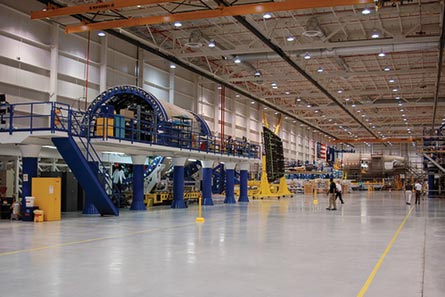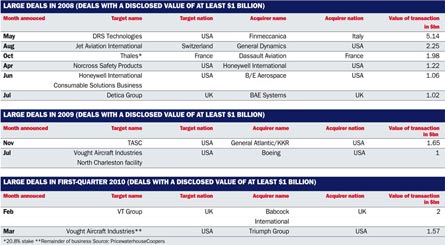An old Wall Street adage runs: "As January goes, so goes the year." On that basis, 2010 is likely to be a busy year of merger and acquisitions in the aerospace and defence market, according to an analysis by consultancy PricewaterhouseCoopers.
In the first quarter - the focus of PwC's most recent investigation of M&A activity in the sector, titled "Mission Control" - the total value of deals struck, at $5.13 billion, was 4.5 times that of the first three months of 2009 ($1.13 billion), even if it was not much above half that of the same period of 2007 ($11.1 billion).

The number of transactions rose to 68, from 63 in the first quarter of 2009. Average transaction value shot up to $244 million, from $70.9 million, and significantly exceeded that of the period 2001-09 as a whole: $188 million.
This is in keeping with a historical tendency of M&A activity to be strong in post-recessionary periods, according to PwC. The recovery has been driven by a return to the market by financial investors, as distinct from strategic investors. In the first quarter, financial investors accounted for three of the eight deals worth $50 million or more. This compares with 11.5% in 2009 and 12.8% in 2008, the third quarter of which brought an exodus of financial investors, and indeed strategic investors, from the market.
The return of financial investors is of course partly explained by easier access to credit, but an additional factor is identified by Neil Hampson, head of PwC's aerospace and defence practice. "There is a better understanding of price expectations between buyer and seller now than there was a year ago, where sellers wanted A and buyers wanted to pay B, and there was a huge gulf between the two," he says. "Now there is much closer alignment as to what value really means."
This in turn is explained by the fact that "a lot of the programme bad news that was very uncertain is now more certain" and that "people just understand that they have to accept less" for businesses they wish to sell, he adds.
Psychological factors may also be at play. "If something came to market 12, 18 months ago, people's first reaction was: there must be something wrong with it," recalls Hampson. "That's certainly not the case any more."
PwC's first-quarter analysis opines that "there are many catalysts in place that support continued strength", citing a shift in the US Department of Defense's priorities - as specified in its Quadrennial Defence Review - as well as the potential of Asian markets, particularly China. While small deals were "the name of the game" in 2009, and still account for a majority of deals, the focus of activity appears to be moving to the middle market.
"With many larger companies deleveraging and shoring up their balance sheets during the recession, there is a lot of dry powder waiting to be put to use," notes PwC, which expects merger activity to be driven by those seeking to enhance scale and productivity by combining with similar companies.
"People now have got a better understanding of where the cycle's going to go, particularly around civil - where the downturn's going to hit and whether it's going to be a hard or soft landing," says Hampson. "The only thing that's still a worry to people is that they're not quite sure how badly defence is going to be hit, both in the UK and the USA, with budget issues. But the overriding view is that it's not going to get better in either country for a long time."
He adds that while emerging markets in India and the Middle East represent "bright patches on the horizon", they "don't necessarily make up for the decline in spending in home markets".
Reflecting a shift toward bigger transactions, the total value of first-quarter deals exceeding $50 million (eight from a total of 68) grew by less than the total value of all the transactions, but was nonetheless 3.5 times higher than in the first quarter of 2009.
North American targets accounted for 41.3% of the value of these deals, compared with 74.3% of 2009 deals. Targets in the UK and Eurozone picked up most of the slack, with their share of deal value rising from 15.7% to 39.7%. The breakdown of acquirers tells a similar story. North American acquirers' share of deal value dropped from 74.7% to 40.2%, the share accounted for by acquirers in the UK and Eurozone grew from 21.4% to 40.9%. However, the low number of deals in this category imperils extrapolation of broad trends.

Three first-quarter deals exceeded $500 million in value, with two valued at more than $1 billion and one at $720 million. In February, Babcock International acquired VT Group for $2 billion. In March, Vought Aircraft Industries was picked up by Triumph Group for $1.57 billion.
In the whole of 2009, there were just two deals that broke the $1 billion threshold: Vought's North Charleston plant came under Boeing ownership in a $1 billion third-quarter deal, and in the fourth quarter General Atlantic and KKR bought TASC for $1.65 billion. There were seven $1 billion-plus deals in 2008, and this year's total "could match or exceed" that, in PwC's view.
"There's a view now that there are bigger businesses coming to market than there have been in the last 12, 18 months," says Hampson. "Are we going to have any gigantic ones? I don't there's any have been rumoured for some time. There's a lot of disposing of non-core assets going on and a lot of filling in of the portfolio. I guess there's a view that now is a good time to start rationalising and refocusing portfolio, mostly among large players. I would expect that to generate quite a reasonable number of businesses coming to market in the next six to 12 months."
Changing deal structures have accompanied the recent revival in M&A activity. There has been an increase in minority stake purchases, and PwC expects joint ventures to gain in popularity. "In some of the emerging markets, people will have to be pragmatic and say, 'We'd like to own something, but either the legal rules or the ability to get customers or contracts prevents us from doing that, so we'll have to do it another way'," says Hampson.
"While joint ventures are never the most economic way of running anything, they're sometimes the most expedient way of doing something." By Hampson's reckoning, cross-border transactions are likely to become both more joint venture-focused and just more common in general. "People will say, 'there's not a lot to go for in the US, UK, western Europe: we've got to start looking overseas'," he predicts.
While only one of the first quarter's eight $50 million-plus deals was a cross-border transaction - UK-based Chemring's move for Alliance Defense - PwC identifies a number of potential avenues to growth. "Foreign defence companies could be eager to tap into the US market via smaller to mid-market acquisitions of US companies," it comments, adding that high growth in Asia and Oceania region will boost deal flow from and to those regions. China's push into business and commercial aircraft manufacture, for example, could drive the nation to pursue strategic acquisitions of technology and supply-chain companies.
Defence companies, meanwhile, could zero in on emergent technology-driven markets such as energy, infrastructure, and cyber security and healthcare privacy. Cost-cutting drives could meanwhile lead potential acquirers to train their sights on companies in eastern Europe and Asia. The financial crisis could also throw up some opportunities, should private-equity companies with attractive assets run into distress. However it plays out, cash-rich companies will surely be eager to take advantage of "the best values we have seen in recent times", to quote the assessment of Bob Filek, a partner with PwC's transaction services practice.
Multiples, which represent ratios of deal value to EBITDA (earnings before interest, tax, depreciation and amortisation), showed signs of contraction, albeit only on big deals, in the first quarter. For transactions exceeding $50 million, the median multiple was 10.4 in the first quarter, compared with 13.1 in 2009 as a whole. However, the equivalent ratio for transactions worth $50 million or less increased from 6.4 to 6.9.
A need for more stringency may slow the pace at which deals are concluded, warns PwC. "Analysing a deal has become more complicated in the wake of a recession that has lessened the reliability of historical results - and led to permanent changes in some segments, because capacity has been taken offline," says the consultancy, adding that a "snap-back" recovery might catch a company off guard if the production capacity, workforce or inventory has been slashed to preserve cashflow during the downturn.
It is a factor to be considered within the process of due diligence which precedes acquisitions, stresses PwC. So too is new US legislation pertaining to climate change and healthcare, it adds, citing the federal government's stipulation that its suppliers and contractors must cut carbon emissions by 28% by 2020 and the potential impact of healthcare reform on employee benefits.
As part of a wide-ranging assessment of changing due diligence requirements, PwC has identified a host of other variables requiring attention. These include commodity price fluctuations - which pose a risk that some companies will not have access to the raw materials required to continue operations - as well as changes to the US tax code and other tax regimes.
The stability and scalability of the target's IT platform and the intricacies of its rewards system must also be scrutinised. Acquisition of foreign entities is complicated not just by foreign currency fluctuations but by the need to comply with International Traffic in Arms Regulations (ITAR), the US Foreign Corrupt Practices Act (FCPA) and local legislation pertaining to taxation, labour practices, exports, trade and the environment. When the transaction is complete, there may be new financial reporting requirements to worry about.

Ongoing availability of financing will depend on assessments of the extent to which the industry is affected by declining GDP, the likely timing and strength of the recovery, the dynamics of the relationship between the health of the wider economy and that of the sector, the level of excess capacity, and the cost implications of scaling capacity up or down to match demand. At the company level, factors under scrutiny will include the credibility of the company's volume projections, as well as its cash position.
"People are much more discerning buyers than [a few years ago]," says Hampson. "I think there's a lot more rigour now than there was. That's not unique to aerospace and defence; it's just that people have got their fingers burned in the recession, with buying businesses that are probably not as robust as they thought they were. So there is a focus on doing things correctly - spending the time and money in advance to make sure that you know what you're buying." Due diligence efforts, which can include contract reviews, should be particularly intensive in cross-border transactions, which create "additional legislative burdens", he adds.
While credit is in general becoming more available, the strings attached can imbue an attitude of caution in financial investors. "People are now putting more money in and relying less on debt than they were," says Hampson, adding that an investor required to put 40% up - versus the bank's 60% - will naturally be "more careful" than one putting up 20%.
Ultimately, a cross-market alignment of perceptions is the key to a continuing revival of M&A activity. "If you get rid of the mismatch between what the expectations of buyers and sellers are, then you can get deals done," says Hampson. "If there's a mismatch nothing happens."
Source: Flight International




















